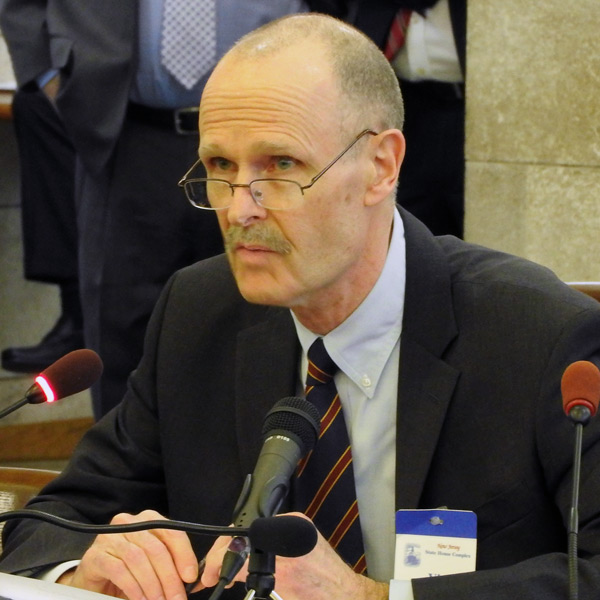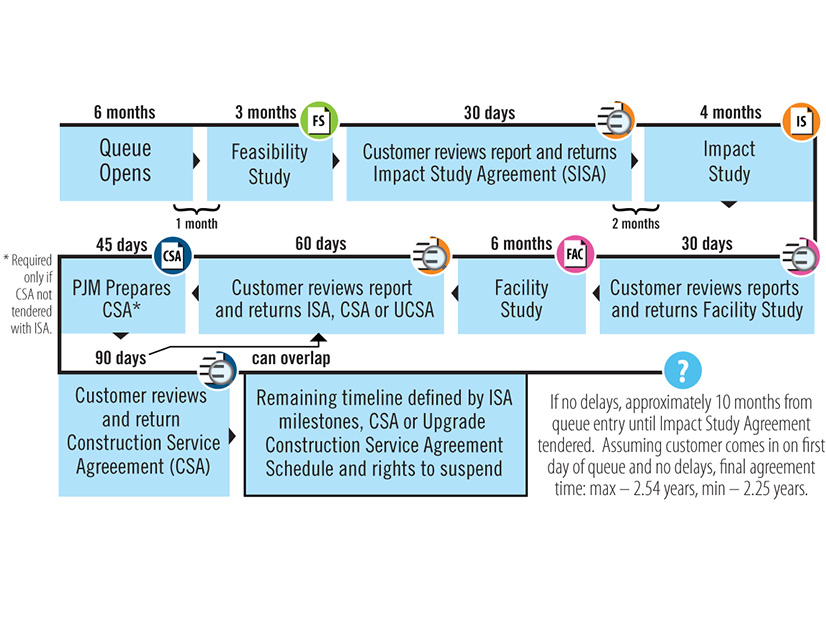Markets and Reliability Committee
ICSA Revisions Endorsed
Stakeholders unanimously endorsed PJM’s proposed tariff revisions to address concerns associated with the pro forma interconnection construction service agreement’s (ICSA) lack of superseding language and current automatic termination provision.
Mark Sims, PJM manager of infrastructure coordination, reviewed the proposed solution and associated tariff revisions at last week’s Markets and Reliability Committee meeting. Sims first presented the issue at the March MRC meeting, with stakeholders providing recommendations to PJM’s proposal.
The Planning Committee endorsed the changes in May, as PJM said the growing interconnection queue volume has created the need for improvements. (See “ICSA Endorsed,” PJM PC/TEAC Briefs: May 11, 2021.)
PJM identified improvements in two areas of tariff Attachment P that deal with ICSAs. Section 1 of the attachment does not contain pro forma language that considers when an ICSA supersedes an already effective agreement, and the solution involved simple tariff language revisions, Sims said.
The tariff also provides for automatic termination of ICSAs upon the occurrence of certain conditions, which can occur without PJM’s knowledge at the completion of construction of all interconnection facilities, a transfer of title, final payment of all costs or delivery of final as-built drawings to the transmission owner. PJM proposes to update the language to make any termination contingent upon PJM receiving notice of the conditions from the TO.
Sims said the changes directly relate to improving process efficiency related to the PJM interconnection queue volume. He said the vetting of the language at the PC and additional review and feedback at the Transmission Owners Agreement-Administrative Committee provided “great feedback” from stakeholders throughout the process.
“As a result, we have a very good proposal,” Sims said.
The tariff revisions will now go to the Members Committee on July 28 for a final vote.
Alex Stern, director of RTO strategy for PSEG Services, thanked PJM staff for “taking a little extra time” to work on the proposal. Stern said the additional work allowed language regarding the automatic termination provisions for conforming and nonconforming agreements to be clarified and enhanced.
Regulation Mileage Ratio First Read
Members questioned PJM’s proposed solution to address issues with the regulation mileage ratio, asking the RTO to reconsider the mileage value it has suggested as an alternative to the existing value.
Michael Olaleye, senior engineer with PJM’s real-time market operations, reviewed the proposed solution addressing the regulation mileage ratio and corresponding revisions to the tariff, the Operating Agreement and Manual 28: Operating Agreement Accounting. Olaleye first introduced the proposed solution at the May Market Implementation Committee meeting. (See “Regulation Mileage Ratio,” PJM MIC Briefs: May 13, 2021.)
Regulation mileage is the measurement of the amount of movement requested by the regulation control signal that a resource is following, and it’s calculated for the duration of the operating hour for each regulation control signal.
PJM’s performance-based regulation market splits the dispatch signal in two: RegA for slower-moving, longer-running units; and RegD for faster-responding units that operate for shorter periods, including batteries. If a signal is “pegged” high or low for an entire operating hour, the corresponding mileage would be zero for that hour.
Olaleye said PJM has seen increased frequency of RegA signal pegging and times the RegA signal is pegged for extended periods. He said the pegging highlights a potential problem in the regulation mileage ratio calculation, setting the RegA mileage at zero for a given hour and creating a divide-by-zero error in the calculation of the mileage ratio.
PJM is proposing to set the floor RegA mileage at 0.1 instead of zero, Olaleye said, which would allow for a “valid solution” for mileage ratio and still maintain market design objectives. He said there would be no impact to the regulation signal design, operations or regulation market clearing.

Independent Market Monitor Joe Bowring raised a counterproposal at the MIC after questioning PJM’s value of 0.1. Bowring proposed a cap of 5.5 on the realized mileage ratio in all hours, indicating the cap would eliminate the current undefined mileage ratio result that PJM is attempting to address, but it in a “preferable way.”
The cap would reduce but not eliminate the market distortion that results from the use of mileage ratios when they incorrectly represent regulation output, Bowring said, and would affect less than 50% of impacted hours based on data collected by the Monitor over the last 15 months.
Bowring said he believes the PJM proposal ignores the fact that there’s still going to be “excessively high” mileage ratios for a significant number of hours.
“It’s important to recognize this is more than just a simple mathematical issue,” Bowring said. “It reflects an underlying issue with mileage ratio.”
Calpine’s David “Scarp” Scarpignato said the numbers currently used in the regulation mileage ratio calculation are “majorly messed up” and need to be addressed. Scarp said Bowring’s solution “makes a lot more sense” than PJM’s because it uses a high mileage ratio but does not create “insane” results. Scarp said dividing by PJM’s 0.1 value “can give you some pretty insane numbers.”
“Joe’s proposal is a temporary fix that actually addresses the real issue, which is more than a mathematical issue,” Scarp said. “It’s where do you reach a point of craziness.”
ELCC Manuals
Andrew Levitt, of PJM’s market design and economics department, reviewed conforming revisions to Manual 18: PJM Capacity Market, Manual 20: PJM Resource Adequacy Analysis, Manual 21: Rules and Procedures for Determination of Generating Capability and Manual 21A: Determination of Accredited UCAP Using Effective Load Carrying Capability Analysis to address the effective load-carrying capability (ELCC) for limited-duration and intermittent resources.
ELCC sets the capacity value for storage and renewables. The revisions would require a unit’s ELCC accreditation to be updated annually based on system conditions and unit performance.
Stakeholders endorsed a revised joint stakeholder proposal to use the ELCC method to calculate the capacity value of limited-duration, intermittent and combination (limited-duration plus intermittent) resources at the September MRC and MC meetings. (See ELCC Method Endorsed by PJM Stakeholders.) Levitt said PJM expects a final ruling by FERC on the ELCC issue by July 30.
Levitt said Manual 18 includes conforming changes to coordinate the term “installed capacity (ICAP)” with new terminology used for ELCC resources, including the new term “accredited unforced capacity (UCAP).”
Manual 20 has a description of the technical details of the ELCC analysis and its methodology, Levitt said, while Manual 21 strikes the “10-hour rule” for limited-duration resources and provides for a sunset date of June 1, 2023, for testing provisions for ELCC resources in the manual.
Levitt said Manual 21A is a new manual describing the business processes for deriving an accredited UCAP value for each ELCC resource.
Stakeholders will be asked to endorse the proposed revisions at the July MRC meeting.
Levitt said PJM is proposing to have ELCC tariff rules currently in front of FERC take effect by Aug. 1 so they’re able to be applied to the 2023/24 delivery year and Base Residual Auction, scheduled for Dec. 1.
Consultant Roy Shanker asked Levitt what PJM would do if FERC doesn’t act on the ELCC proposal by July 30.
Levitt said FERC has a statutory obligation to make a decision by July 30. He said if the commission’s decision involves a denial of the ELCC proposal or moving the decision date, PJM would have to “assess our options.” He said he has a “difficult time seeing” how PJM could run the 2023/24 BRA under ELCC rules if FERC doesn’t approve them on time.
Manual 14 Revisions Endorsed
Stakeholders endorsed revisions to Manual 14B: PJM Region Transmission Planning Process and Manual 14F: Competitive Planning Process conforming to tariff revisions accepted by FERC in December (ER21-162) in the MRC consent agenda.
PJM proposed including capacity constraints as inputs to the analysis for market efficiency projects in the Regional Transmission Expansion Plan and to clarify when capacity benefits of such projects are calculated. Both manual changes were unanimously endorsed at the May PC meeting. (See “Manual 14F and 14B Updates,” PJM PC/TEAC Briefs: May 11, 2021.)
Members Committee
Consent Agenda
Two proposals were endorsed with two objections as part of the consent agenda at last week’s MC meeting.
Stakeholders endorsed tariff revisions to address new service requests deficiency review requirements. Members unanimously endorsed the proposed solution and tariff revisions at the May MRC meeting. (See “New Service Requests Approved,” PJM MRC Briefs: May 26, 2021.)
Members also approved OA revisions to address the avoidance of future CIP-014 facilities. The avoidance proposal was approved by an acclamation vote at the May MRC meeting. (See “CISO Avoidance Endorsed,” PJM MRC Briefs: May 26, 2021.)


